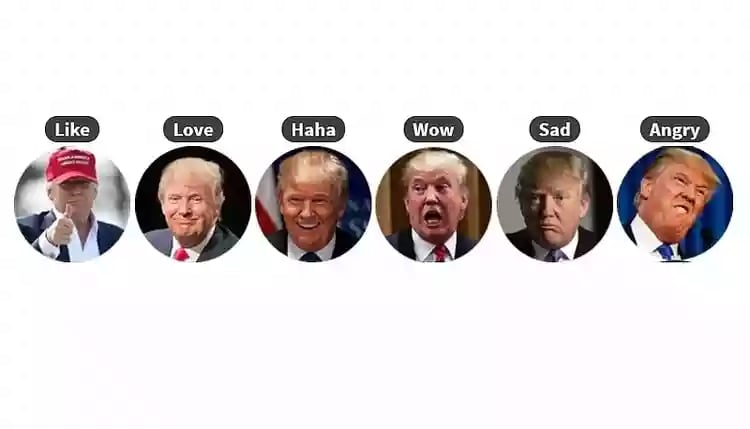February 26, 2016
Facebook Reactions – becoming a social norm.
April 22, 2016

As Jeff Bercovici (San Francisco bureau chief of Inc.) noted in his article a couple of weeks ago Facebook has quietly shifted into crisis mode with users sharing less–way less. One of the measures Facebook has taken to increase value (and so engagement) for its users has been with the introduction of Facebook Reactions. My initial reaction to Reactions was that Facebook had played with the one thing everyone knew them for and a swift retraction of the new functionality would happen as users struggled with this seismic change in digital parlance. I drew the analogy of Coca Cola and New Coke.
Well, we’re a couple of months on and it seems, for now at least, that I’ve been proven wrong. I’ve even found myself using the emoji. Sad emoji for the many posts today on the news of Prince’s death for example where “Like” really didn’t seem appropriate. Angry emoji for anything Trump related and so on. I’ve also spent some time looking at hundreds of posts on lots of subjects trying to understand how the emoji are being used. As a straw-poll of one, it seems that 90% of Reactions are still “Like” and the rest are a combination of the other emoji.
To do some more exploration and find out if overall engagement has improved with Facebook Reactions I’ve spoken with twenty people around the world whose job it is to manage brand or personality Facebook pages. With a collective following of well over 10 million Facebook users I’ve been able to get a broad picture of the impact of Facebook Reactions (from a professional page point of view if not a personal one).
Two very clear themes:
1. Overall engagement is down… but not much, feels like a drop of 5-10%.
2. Much clearer picture of sentiment… and this is much more useful.
So, while overall engagement has dropped slightly, the quality of engagement has risen significantly. Some cases in point…
Maree from Luckie & Company who manage Facebook pages for a number of clients explained that:
“Mostly, it gives us a clearer picture of sentiment, which can be difficult to measure unless you have the right tools. A “like” can mean a number of things, but a “love” or a “haha” can give a new, specific meaning to the content you produce. The red flags for me are when I see “sad” or “angry eyes” on our pages, because that’s never a good sign, especially if the overarching theme of your content is to share moments of joy. These reactions allow us to constantly be held accountable for the quality of content we produce.”
Chicago based Kamila from Kamila Social llc said:
“I’ve found that reactions have allowed more people to engage with the content I produce on my Facebook posts and my clients’ Facebook ads. It’s a great way to encourage a different type of engagement and I’ve been able to determine the temperature of my audience as well, understanding whether (and how much) they are interested in a specific topic which is invaluable when creating future content or products.”
An interesting insight from a B2B point of view came from Matthew at Dupray who sell steam cleaners and steam irons:
“The Facebook Reaction changes give us more detailed information about the outcome of each interaction. From our perspective, a reaction gives a non-verbal (yet accurate) portrait of how an individual is actually feeling. A “like” is simply and requires minimal effort. A reaction requires more effort (choosing and selection the ideal icon). When we see significant numbers of reactions on a post, we can reverse engineer the quantifiable elements of a post to determine how to maximize our return. When many people find a post exciting, we can examine the content to figure out why they are excited. Was it because we released a new product model? Was it because we had a witty statement?”
Billy from Royce Leather also talked about how Reactions is allowing his company to manage negative sentiment:
“Even as a subset of Likes, Reactions could have a serious impact on how you communicate with your audience. So far, that communication has been surprisingly binary: when users like a post, they hit the ‘Like’ button. When they don’t, they have the opportunity to comment, but most times they simply ignore it. Broadening the spectrum of potential responses means potentially inviting negative responses to your posts.”
Dimitri from Yacht Harbour in Monaco:
“With the addition of reactions, it has become easier to measure which fans are most engaged with the brands. Adding a like is a quicker action than reacting. This implies that people reacting are paying more attention to your content and have likely read more attentively your post. Reactions also seem to mitigate the stigma users have reacting to a lesser amount of posts, as up to 3 reactions are displayed. This implies that people will relate more positively to a brand that is getting reactions.”
Nathan from Australian based SEOWorks:
“Since the introduction of Facebook reactions, we are able to more easily decipher how our audience is reacting to the content that we are posting. Before the reactions update, the only way to get deeper insights on our social media as to how people felt about our company was through the comments. The “like” button helped promote the content further, but we were unable to understand any emotion responses through it. Now, for example, we can tell if people love it, hate it, are happy, sad, etc. These insights are helpful in giving us feedback as to what types of content to keep producing, and which ones to stop. This is helping us guide or Facebook posting strategies overall to give our audience the type of content that they want most.”
Sam from Fife Man Removals:
“Although controversial at first, Facebook reactions seem to have been accepted as a welcome addition to the Facebook dashboard. But since the reactions feature was rolled out, we’ve noticed a huge change in the engagement that we have on our page. Instead of users commenting on our posts, many of them now simply leave a reaction. This has made our page seem less active, which has potentially lessened the chance of a new user deciding to like our page.”
And finally Jason from Majesty Diamonds in Qubec:
“We’re getting a lot of good feedback on our posts through Facebook Reactions. The posts that receive the most reactions such as “love” or “wow” gives us a good indication of what the popular trends among jewelry and gives us insight about how we should structure our social schedule.”



